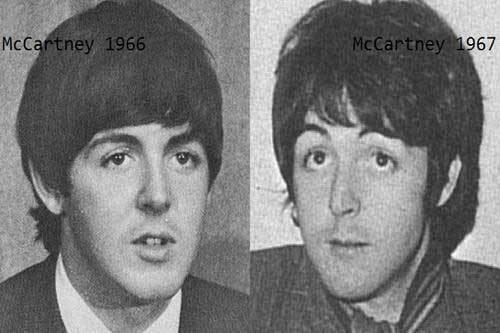 | ||
"Paul is dead" is an urban legend and conspiracy theory alleging that Paul McCartney of the English rock band the Beatles died in 1966 and was secretly replaced by a look-alike.
Contents
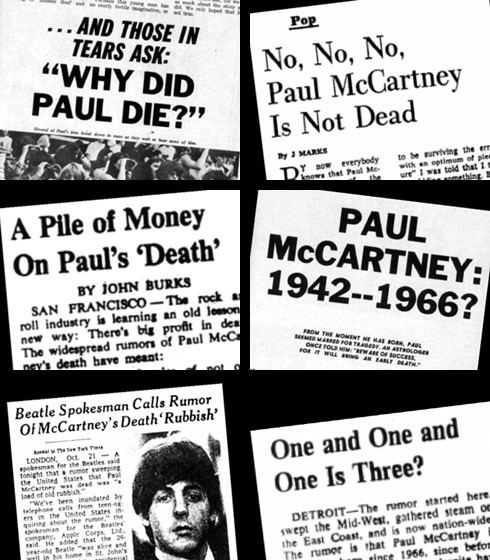
In September 1969, American college students published articles claiming that clues to McCartney's supposed death could be found among the lyrics and artwork of the Beatles' recordings. Clue-hunting proved infectious and, within a few weeks, had become an international phenomenon. Rumours declined after a contemporary interview with McCartney was published in Life magazine in November 1969.
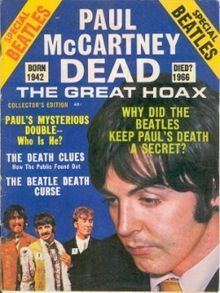
Popular culture continues to make occasional references to the legend. McCartney himself poked fun at it with a 1993 live album, titling it Paul Is Live, with the cover parodying clues allegedly on the cover of the Beatles' Abbey Road album.
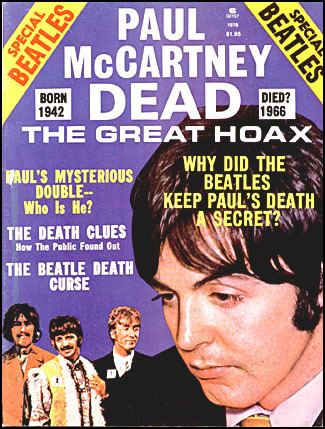
Paul is dead conspiracy
Beginnings
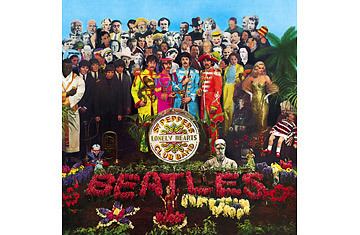
A rumour circulated in London that Paul McCartney had been killed in a car crash after a January 1967 traffic accident involving his Aston Martin. The rumour was acknowledged and rebutted in the February issue of The Beatles Book fanzine, but it is not known whether the rumour of 1969 is related to it. In October 1969, the Beatles had just released their Abbey Road album and were in the process of disbanding. McCartney's public engagements were few and he was spending time at his Scottish retreat with his new wife Linda to contemplate his forthcoming solo career.

On 17 September 1969, Tim Harper, an editor at the student newspaper of Drake University in Iowa (the Drake Times-Delphic) published an article titled "Is Beatle Paul McCartney Dead?" The article described a rumour that had been circulating on campus that Paul was dead. At that point, the rumour included numerous clues from recent Beatles albums, including a message, interpreted as "turn me on, dead man," that is heard when "Revolution 9" from the White Album is played backwards. In wire reports published as early as 11 October, Beatles press officer Derek Taylor responded to the rumour saying, "Recently we've been getting a flood of inquiries asking about reports that Paul is dead. We've been getting questions like that for years, of course, but in the past few weeks we've been getting them at the office and home night and day. I'm even getting telephone calls from disc jockeys and others in the United States."
Growth
On 12 October 1969, a caller to Detroit radio station WKNR-FM told disc jockey Russ Gibb about the rumour and its clues. Gibb and other callers then discussed the rumour on the air for the next hour. Two days after the WKNR broadcast, The Michigan Daily published a satirical review of Abbey Road by University of Michigan student Fred LaBour under the headline "McCartney Dead; New Evidence Brought to Light". It identified various clues to McCartney's death on Beatles album covers, including new clues from the just-released Abbey Road LP. LaBour had invented many of the clues, and he was astonished when the story was picked up by newspapers across the United States. WKNR-FM further fuelled the rumour with a special two-hour program on the subject, "The Beatle Plot", which aired 19 October 1969 (and in the years since on Detroit radio).
In the early morning hours of 21 October 1969, New York radio station WABC's disc jockey Roby Yonge discussed the rumour on the air for over an hour before being pulled off the air for breaking format. At that time of night, WABC's signal covered a wide listening area and could be heard in 38 states and, at times, in other countries. Later that day, the Beatles' press office issued statements denying the rumour which were widely reported by national and international media.
Various clues were used to suggest the following story: three years previously (on 9 November 1966), McCartney had an argument during a Beatles' recording session and had angrily driven off in his car. He had crashed it and died as a result. To spare the public from grief, the Beatles replaced him with "William Campbell", the winner of a McCartney look-alike contest.
Clues
Hundreds of supposed clues to McCartney's death have been reported by fans and followers of the legend. These include messages perceived when listening to a song being played backwards and symbolic interpretations of both lyrics and album cover imagery. One oft-cited example is the suggestion that the words "I buried Paul" are spoken by McCartney's band-mate John Lennon in the final section of the song "Strawberry Fields Forever". Lennon later explained that the words were actually "cranberry sauce". Another is the interpretation of the Abbey Road album cover as symbolising a funeral procession, where Lennon, dressed in white, symbolises the heavenly figure. Ringo Starr, dressed in black, symbolises the undertaker, George Harrison, in denim, symbolises the gravedigger, and McCartney, barefoot and out of step with the others, symbolises the corpse. In the background, a car's license plate reads "28IF" meaning that Paul would have been 28 years old if he had lived (although McCartney was 27 at that point in 1969, not 28).
Rebuttal
On 21 October 1969, the Beatles' press office issued statements denying the rumour, deeming it "a load of old rubbish" and saying that "the story has been circulating for about two years—we get letters from all sorts of nuts but Paul is still very much with us." Rumours started to decline when, on 7 November 1969, Life magazine published a contemporary interview with McCartney in which he said,
Perhaps the rumour started because I haven't been much in the press lately. I have done enough press for a lifetime, and I don't have anything to say these days. I am happy to be with my family and I will work when I work. I was switched on for ten years and I never switched off. Now I am switching off whenever I can. I would rather be a little less famous these days.
Aftermath
In November 1969, Capitol Records sales managers reported a significant increase in sales of Beatles catalogue albums, attributed to the rumour. Rocco Catena, Capitol's vice president of national merchandising, estimated that "this is going to be the biggest month in history in terms of Beatles sales." The albums Sgt. Pepper's Lonely Hearts Club Band and Magical Mystery Tour had been off the charts since February, but both re-entered the Billboard Top LP's chart.
Before the end of October 1969, several records were released on the subject, including "The Ballad of Paul" by the Mystery Tour, "Brother Paul" by Billy Shears and the All Americans, and "So Long Paul" by Werbley Finster, a pseudonym for José Feliciano.
Terry Knight, a singer on Capitol Records, had witnessed the Beatles' White Album session during which drummer Ringo Starr had walked out and, in May 1969, released a song called "Saint Paul" about the impending break-up of the Beatles. The tune made its way to the Bubbling Under Hot 100 chart at No. 114 in late June that year and was quickly forgotten until a few months later, when it was picked up by radio stations as a tribute to "the late" Paul McCartney.
A television programme was broadcast on WOR in New York on 30 November 1969, hosted by celebrity lawyer F. Lee Bailey, in which Bailey cross-examined LaBour and other "witnesses" about the rumour, but he left it to the viewer to determine conclusions. Before the recording, LaBour told Bailey that his article had been intended as a joke, and Bailey sighed and replied: "Well, we have an hour of television to do; you're going to have to go along with this."
Both Lennon and McCartney subsequently referred to the legend in their music, Lennon in his 1971 song "How Do You Sleep?" (describing as "freaks" those who had spread the rumour), and McCartney with his 1993 live album titled Paul Is Live (parodying the Abbey Road cover and its clues).
LaBour later became notable as the bassist for the western swing group Riders in the Sky, which he cofounded in 1977. In 2008, he joked that his success as a musician had extended his fifteen minutes of fame for creating the "Paul is Dead" hoax to "seventeen minutes". In 2015, he told The Detroit News that he is still periodically contacted by conspiracy theorists who have attempted to present him with supposed new developments on the McCartney rumours.
In popular culture
There have been many references to the legend in popular culture. Examples include:
